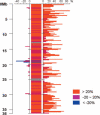Sequence, annotation, and analysis of synteny between rice chromosome 3 and diverged grass species
- PMID: 16109971
- PMCID: PMC1199543
- DOI: 10.1101/gr.3869505
Sequence, annotation, and analysis of synteny between rice chromosome 3 and diverged grass species
Abstract
Rice (Oryza sativa L.) chromosome 3 is evolutionarily conserved across the cultivated cereals and shares large blocks of synteny with maize and sorghum, which diverged from rice more than 50 million years ago. To begin to completely understand this chromosome, we sequenced, finished, and annotated 36.1 Mb ( approximately 97%) from O. sativa subsp. japonica cv Nipponbare. Annotation features of the chromosome include 5915 genes, of which 913 are related to transposable elements. A putative function could be assigned to 3064 genes, with another 757 genes annotated as expressed, leaving 2094 that encode hypothetical proteins. Similarity searches against the proteome of Arabidopsis thaliana revealed putative homologs for 67% of the chromosome 3 proteins. Further searches of a nonredundant amino acid database, the Pfam domain database, plant Expressed Sequence Tags, and genomic assemblies from sorghum and maize revealed only 853 nontransposable element related proteins from chromosome 3 that lacked similarity to other known sequences. Interestingly, 426 of these have a paralog within the rice genome. A comparative physical map of the wild progenitor species, Oryza nivara, with japonica chromosome 3 revealed a high degree of sequence identity and synteny between these two species, which diverged approximately 10,000 years ago. Although no major rearrangements were detected, the deduced size of the O. nivara chromosome 3 was 21% smaller than that of japonica. Synteny between rice and other cereals using an integrated maize physical map and wheat genetic map was strikingly high, further supporting the use of rice and, in particular, chromosome 3, as a model for comparative studies among the cereals.
Figures



References
-
- Ahn, S., Anderson, J.A., Sorrells, M.E., and Tanksley, S.D. 1993. Homoeologous relationships of rice, wheat and maize chromosomes. Mol. Gen. Genet. 241: 483-490. - PubMed
-
- Altschul, S.F., Gish, W., Miller, W., Meyers, E.W., and Lipman, D.J. 1990. Basic local alignment search tool. J. Mol. Biol. 215: 403-410. - PubMed
-
- Baba, T., Katagiri, S., Tanoue, H., Tanaka, R., Chiden, Y., Saji, S., Hamada, M., Nakashima, M., Okamoto, M., Hayashi, M., et al. 2000. Construction and characterization of rice genomic libraries: PAC library of japonica variety, Nipponbare and BAC library of indica variety, Kasalath. Bull. NIAR 14: 41-49.
WEB SITE REFERENCES
-
- ftp://ftp.tigr.org/pub/data/rice/rice.chr03.v2.1/; annotation data for chromosome 3.
-
- http://www.agcol.arizona.edu; Arizona Computational Genomics Lab.
-
- http://www.cbs.dtu.dk/services/SignalP-2.0/; SignalP Server.
-
- http://www.cbs.dtu.dk/services/TMHMM/; TMHMM Server v 2.0.
Publication types
MeSH terms
Substances
Associated data
- Actions
LinkOut - more resources
Full Text Sources
Other Literature Sources
Research Materials
Miscellaneous
